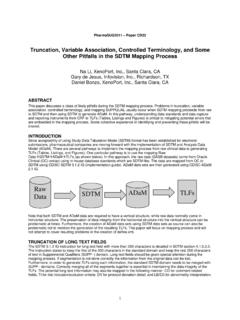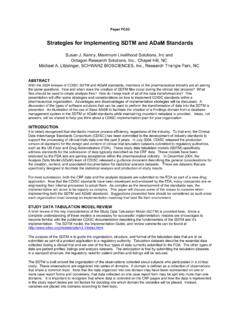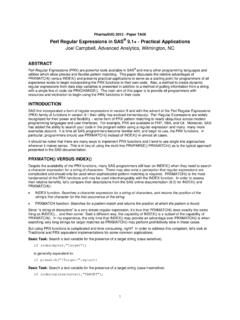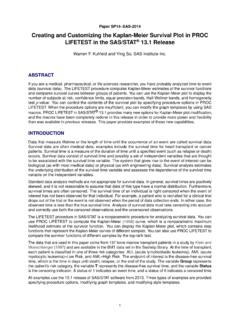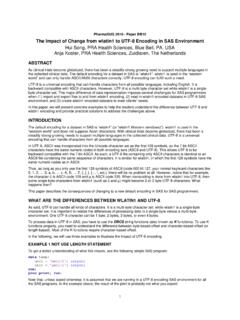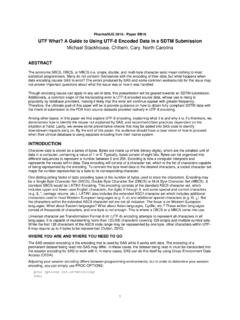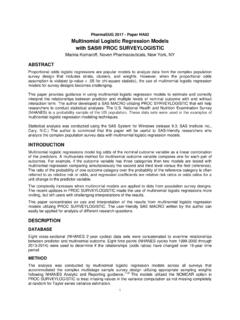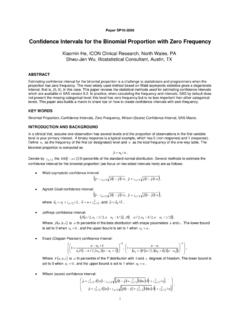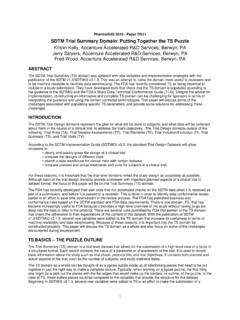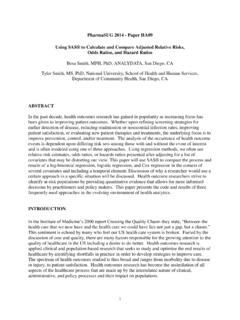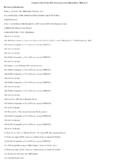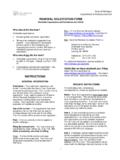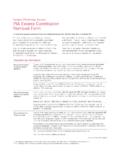Transcription of A Macro to Produce a SAS® Data Set Containing …
1 1 PharmaSUG 2015 - Paper QT23 A Macro to Produce a SAS Data Set Containing the List of File Names Found in the Requested Windows or UNIX Directory Mike Goulding, Experis, Portage, MI, USA ABSTRACT Clinical programmers often need to perform a particular process for each file that exists in a specific directory, on Windows or UNIX. For example, consider a directory that contains SAS V5 transport files, which need to be converted back to standard data sets, perhaps as part of doing a final quality check prior to regulatory submission. To run through the conversion step for all these files dynamically, somehow the programmer must first create a data structure which contains the file names in the target directory.
2 This paper presents the Macro dir_contents, which captures all file names from the requested directory, and returns the file names as observations within a SAS data set. In this structure, the data set can be readily processed by a subsequent Macro do-loop, to perform whatever procedure might be appropriate. The Macro performs basic error checking, and supports filtering the requested directory by file extension. The Macro obtains the information using SAS software functions rather than system-specific commands, to ensure complete portability between Windows and UNIX. INTRODUCTION SAS software is widely used on two directory-based operating systems: Windows and UNIX.
3 One of the most basic tasks common to both of these systems is to determine which files exist within a particular directory. File lists can be generated via the command line interface, using a system-specific command (dir for Windows, ls on UNIX), but those commands only display the file list on the screen; the list is not immediately usable by a SAS program. Numerous methods exist to capture the file list based on using the PIPE option of the FILENAME statement, but implementations are unique to each operating system, and they also involve somewhat esoteric parsing of the command output stream. The dir_contents Macro was written with these challenges in mind.
4 The Macro provides a straightforward, reusable means of obtaining the directory list and saving it in the familiar form of a SAS data set. The design concept assumes that in this form, the file list can then be used as metadata to drive any type of downstream user-written Macro which iterates for each file name and performs a SAS process that operates on each file in the directory. Here are just a few possible applications where the directory information returned by the Macro could be leveraged in a subsequent Macro %do loop: Import all Excel or .csv files found in one directory Find the most recently created file in a directory and process only that file Scan all log files in a directory for critical errors and warning messages One illustrative example will be shown in detail, later in the paper.
5 The Macro 's scope lends itself to a modular approach; details of extracting directory contents are de-coupled from any dependent Macro activity that follows. Macro KEYWORD PARAMETERS Parameter Description DIR Full name of directory to process. REQUIRED, no default. EXT File extension to apply as a filter. Optional, default is no filtering: all file names are returned. DSOUT Output data set name, one- or two- level. Optional, default is ATTRIBS Flag (Y or N) to pull in additional file attributes such as creation date. Optional, default = N. Table 1. Macro parameters A Macro to Produce a SAS Data Set Containing the List of File Names Found in the Requested Windows or UNIX Directory, continued 2 ERROR CHECKING The Macro performs basic error checking and will exit with an informative message if any of these conditions is found: The DIR required parameter is blank.
6 The specified directory does not exist. The specified directory could not be opened. The directory has zero files, or no files matched the specified value for the optional parameter EXT=. OUTPUT DATA SET STRUCTURE Variable Description BASEFILE Name of file (base file name only, without path) PATHNAME Full path name of file including directory name FILE_SEQ Sequence number of the file The following variables are added to the data set only when ATTRIBS = Y is requested: Variable Description Operating system Owner_Name File owner's ID UNIX Group_Name Permission group Access_Permission Permission string Last Modified Date file created/modified File_Size__ Bytes File size in bytes RECFM Record format Windows LRECL Logical record length File_size__bytes File size in bytes Last_Modified ddMONyyyy:HH:MM:SS Create_Time ddMONyyyy:HH:MM:SS Table 2.
7 Output data set structure Sample Output Owner_ Obs basefile file_seq Pathname Name 1 1 /home/goulding/Experis/ goulding 2 2 /home/goulding/Experis/ goulding 3 3 /home/goulding/Experis/ goulding 4 4 /home/goulding/Experis/ goulding 5 5 /home/goulding/Experis/ goulding File_ Group_ Access_ Size__ Obs Name Permission Last_Modified bytes_ 1 users rwxrwxr-x Wed Oct 9 11:28:35 2013 110400 2 users rwxrwxr-x Wed Oct 9 11:28:36 2013 6800 3 users rwxrwxr-x Wed Oct 9 11:28:36 2013 34800 4 users rwxrwxr-x Wed Oct 9 11:28:37 2013 11680 5 users rwxrwxr-x Wed Oct 9 11:28:39 2013 3775600 Output 1.
8 Output data set created by the Macro (running on HP-UX) A Macro to Produce a SAS Data Set Containing the List of File Names Found in the Requested Windows or UNIX Directory, continued 3 CODING EXAMPLE - USING THE Macro 'S RESULT TO DRIVE SUBSEQUENT PROCESS In this scenario, we are required to process a directory full of SAS version 5 transport files. Figure 1. Sample directory contents to be processed The dir_contents Macro is called to Produce a data set with the names of all files having the target extension, .xpt. /* first call the Macro to Produce the data set: */ %dir_contents(dir=/home/goulding/Experis /xptsdtm, ext=xpt, dsout=xpt_sdtm); After the Macro completes, the next section of the code within a Macro loop runs a PROC COPY step once for each file, to convert each transport file into a standard SAS data set.
9 To drive the loop, the pathname values are loaded into a series of Macro variables. (The global Macro variable, &_dir_fileN, was created within dir_contents.) /* populate a series of Macro variables that contain the file names */ proc sql noprint; select pathname into :path1 thru :path&_dir_fileN from xpt_sdtm; quit; /* process the names from the data set within a Macro loop */ % Macro run_loop; %do i = 1 %to &_dir_fileN; libname xlib xport "& proc copy in=xlib out=work; run; %end; %mend run_loop; %run_loop TECHNICAL DETAILS AND LIMITATIONS The Macro has one main data step that uses the functions listed below to first identify the number of files within the directory, and then builds the output SAS data set from the directory contents.
10 DOPEN to open the specified directory file DNUM to return the number of files that are in the directory DREAD to retrieve the name of each individual file DCLOSE to close the directory file after all file names are processed A Macro to Produce a SAS Data Set Containing the List of File Names Found in the Requested Windows or UNIX Directory, continued 4 Optionally, if the calling program specifies ATTRIBS = Y, then the Macro performs a secondary data step that uses the functions listed below to access the available file attributes; these are then transposed and merged onto the primary data set as additional variables, one variable per file attribute. FOPEN to open each individual file FOPTNUM to return the number of information items (attributes) that are available about each file FOPTNAME to return the name for each attribute FINFO to return the attribute s value FCLOSE to close the file after attributes are obtained The Macro has a few limitations to be noted.
